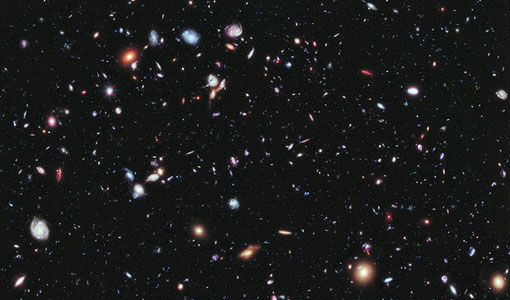
As this year rapidly draws to a close, one can look back appreciatively on all of the scientific achievements that have been made in the past eleven months. Scientists created a powerful lens capable of rendering an object invisible for 40 trillionths of a second; NASA sent the Curiosity rover to Mars, where it is conducting extraordinary research; and a form of water has been found on Mercury.
Perhaps most interesting of all was the completion of the Hubble XDF in September; it is a photo ten years in the making, which now provides the deepest, most extensive view of the universe ever seen.
On September 27, millions of people, this writer included, gathered at a web seminar on Google+, where the Hubble XDF (eXtreme Deep Field) observing team – Garth Illingworth, Pascal Oesch, and Dan Magee – presented information on how they assembled the historic image. The three astronomers also took questions, both on Google+ and on YouTube, where the ‘webinar’ was also streaming.
“The XDF represents the deepest images ever taken of the sky,” said Illingworth. “It is the product of ten years of assembling photos from [the Hubble space telescope’s] cameras. We took all the data from those images and combined it to make the eXtreme Deep Field.” Projects like this are extremely important, he remarked, because they are “the key to understanding the origins of galaxies.”
What’s incredible about the XDF, he marvelled, is that it technically allows us to look into the past. “The blue stars,” for example, “represent very early galaxies that were filled with them. Those galaxies are so distant – light from there takes so long to reach us – that we’re actually looking 13.2 billion years into the past.” That’s not too long after the Big Bang, which is estimated to have occurred 13.7 billion years ago.
Magee pointed out that, while the XDF is amazing in its own right, with each light speck in the image representing a galaxy, it captures merely a small part of the sky. The universe is believed to contain about 200 billion galaxies.
Even whilst representing just a tiny fraction of the universe, consider that the data of the image was a gargantuan 250 gigabytes in size, and had to be uploaded from the Hubble Archive in small pieces. All 2,000 images that would make up the XDF then had to be visually inspected, and had to be aligned together perfectly in order to be scientifically useful, Oesch explained.
Illingworth described the XDF a bit more, detailing what each color represented. The red dots are galaxies that were created 800 million years after the Big Bang, and “cannot be seen by the human eye,” he said. “Fortunately, they can be seen in infrared light, and that was how those galaxies were imaged for the photo.” Green galaxies, meanwhile, usually represent “galaxies that are aging.” The dust effect of the old galaxies is what causes the green hue.
The astronomers lamented the fact that Hubble is incapable of seeing galaxies in non-infrared that were born earlier than 400 million years after the Big Bang. But NASA is already working on solving that problem. “The James Webb Space Telescope,” said Illingworth, which should be rolled out by 2018, “should be able to see those galaxies.”
One of the chief questions asked by mystified viewers was, “How can we look so far back in time?”
Illingworth replied, “The distances between galaxies are billions of light years. Light takes time to cover a distance, making it a simple matter of how far off in the distance Hubble can see. We on Earth always see the sun as it was eight minutes ago. We are seeing some of these galaxies as they were 13.2 billion years ago. The principle is the same.”
Also interesting, said the astronomers, is that the galaxies we can now review in the XDF image will someday change or become entirely different. “Some will ultimately collide and become merged galaxies,” said Illingworth. “Others may change in color. This will all happen because the universe is expanding. One analogy I’d like to use as an example is this: Imagine that you have a loaf of raising bread baking in the oven. As it does so, it expands, and as that happens, all those raisins gradually move further apart from one another.” Thus, for all intents and purposes, our universe is the bread, and the stars are the raisins.
The XDF is remarkable in that it allows an ordinary person to view a panoramic image of the immediate portion of the universe that lay beyond Earth. It’s the first step, said the scientists. The second would be to do yet another, even more detailed XDF. “The great thing,” said Illingworth, “is that we are always trying to understand more. At the broadest level, it is a bit of a ‘penultimate goal’ of ours to use the [upcoming] James Webb telescope to find the very first galaxies. Then, the following step would be searching for planets.”
As the webinar concluded, someone asked, “As the search continued, what if it were possible for a telescope to look back even farther than the Big Bang?”
“That,” Illingworth laughed, “is more of a question for theorists and philosophers.”
Photo: A portion of the XDF. NASA/Flickr










